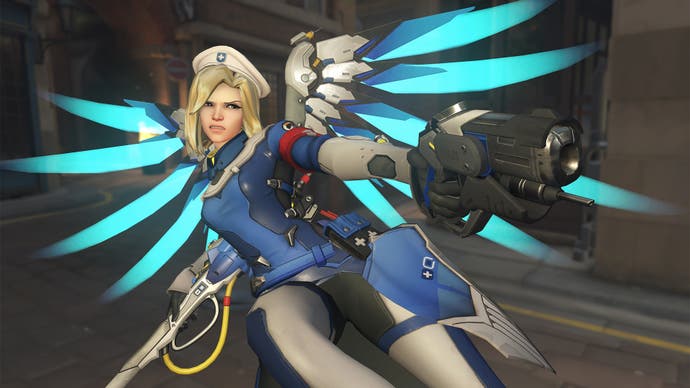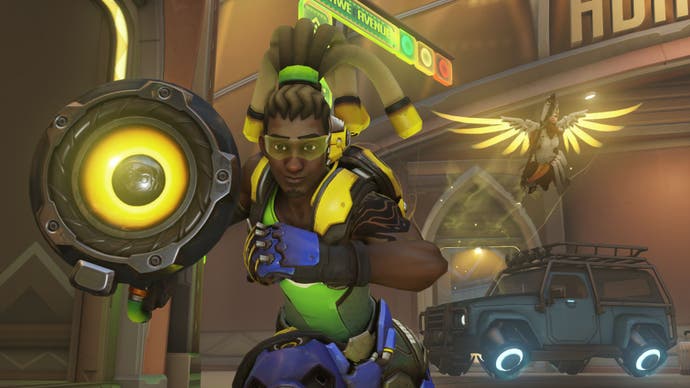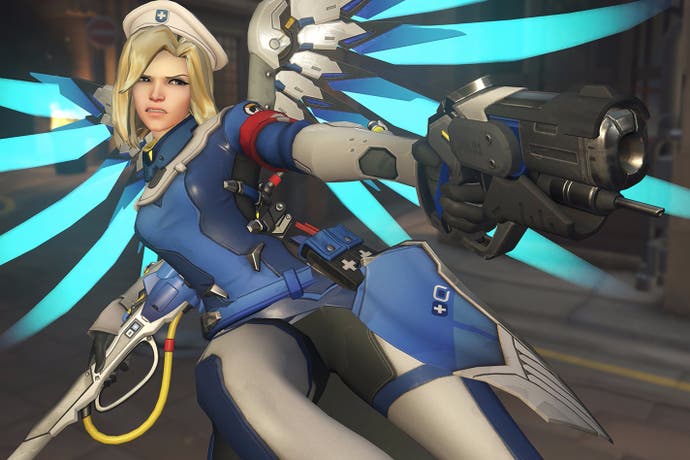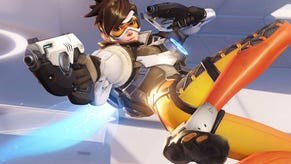Mercy me: in praise of gaming's greatest healer
Now, where am I needed?
I've picked a hell of a time to pen a love letter to Mercy. As these words are being written, the Overwatch-playing internet is having kittens over the long-awaited arrival of Doomfist - Talon elder, social Darwinist and a pugilist whose right hooks show up on a seismograph. Doomfist is yet another damnably cool addition to a line-up of damnably cool characters, all of them worthy of a game by themselves. His most terrifying facet may be his passive ability, which applies a fresh layer of overshield for every punch that connects, allowing a rampaging player to weather the concentrated wrath of the other team. But he's still going to need a medic at some stage, particularly if he falls into Sombra's clutches, and who better to supply the juice than a cybernetic valkyrie from Switzerland.
Part of Mercy's thrill is that she actively leans into a healer stereotype many shooters hurry to distance themselves from, a departure possible because Blizzard's stock in trade is not, after all, shooters, but strategy, MMO and role-playing games, where support roles are a honoured profession rather than a tedious odd-job, palmed off on greenhorns. Consider her radiant halo, her saintly smirk, her habit of theatrically enquiring "Must violence always be the solution?" while the team limbers up. Consider her sole offensive ability, a paltry sidearm used to polish off wounded targets when there's absolutely no other option.
From afar this would seem to propagate certain smelly patriarchal ideas about care being a woman's - no, a lady's vocation, but as ever with Overwatch's wanton plundering of pop clichés, there's a degree of irony to Mercy's matronly demeanour. "So that's what it feels like," she declares archly, when somebody takes the time to amplify her damage. In any case, the brilliance of Mercy is that her healing capacities are anything but expressive of some demure gender-normative passivity, a question of throwing down auras and waiting for the team's heavy hitters to drop by. Rather, they unite with her eccentric movement abilities to create a high level playstyle that is, I think, unprecedented in shooters, a blend of agility and aggression which views team mates as handholds first, patients second.

Using Guardian Angel, Mercy can lock onto and swoop towards any ally within a generous range, including (in one of the many macabre touches that speckle Overwatch's wholesome veneer) the effervescing souls of the recently slain. The immediate effect is to transform a dawdling, fragile medic into a flanker on par with Genji, flitting across a killzone to rescue a cornered Reinhardt or shelter behind D.Va's anti-projectile field. There's a short cooldown on Guardian Angel and you can use Mercy's self-buffing glide to fill in the gaps, so it's possible to effect some exhilarating, Bionic Commando-esque combos, providing of course you keep the players you're grappling between in rude health.
Given a halfway-capable tank, this lends itself to some amazing double acts - one of my fondest memories is of tackling all six opponents with a single Zarya player, hurtling around behind her on a whisper of health while she sponged up rockets and shut down our attackers, one by one. All of which makes earning her affection a matter of some urgency for any character built to dish it out, rather than take it. The unspoken question in most Overwatch locker rooms is "who is Mercy's favourite today?" Will she side with Reinhardt, that ponderous, dependable stormfront, or take a risk on an offensive class? Be sure to greet and thank her repeatedly, and maybe throw in an emote for good measure. But don't get in her face too much, for heaven's sake - Mercies are nothing if not contemptuous of attention-seekers, particularly those who wield a katana and are drawn to trouble like spaniels to dropped icecream.

The implications of Guardian Angel extend beyond the timeless tank-or-DPS-and-healer tango, however - it catalyses team cohesion and positioning like few other classes, because everybody needs to be within line of sight of Mercy for her to work her magic. You'll want a Hanzo up high not just for the sake of reconnaissance and nailing the other team's supports, but so she has somewhere to retreat to when Reaper is closing in. You'll want a Soldier 76 on the corner so she can tuck herself out of view, powering him up while he slaps down his own healing ability, and perhaps a Bastion a few metres behind so she can swoop back and super-charge the rearguard when ambushed by Tracer.
There's an interesting comparison to draw with Lucio, whose fire-and-forget area-of-effect heals make him the more obvious way of fostering teamplay (and who is far better equipped to fend for himself should his allies desert him, bounding along walls or the payload to the immense annoyance of the attacking team). Lucio's AOE focus also, however, sets up the team nicely for an enemy crowd control Ultimate like Zarya's gravity bomb, whereas Mercy's very particular set of skills permit allies to space themselves out. If he's a pulsing electro-house track, gathering everybody together into a joyful mob, she's more of a loosely woven jazz number, allowing individual performers to strut their stuff without slipping out of rhythm.
And then, of course, there's her own necromantic Ultimate, Overwatch's original and (even post-nerf) most enduring comeback move - the equivalent of grabbing a skidding car by its fender in order to hurl it back onto the road, just before it crashes into a tree. True, it lacks the raw gratification of say, Doomfist's Ultimate, an air-to-ground nuclear slam which flattens anybody it doesn't kill outright. But when the smoke clears and the reverberations die away, there's nothing like the horror of seeing every slaughtered foe restored to full vitality in a blaze of gold, as Mercy triumphantly emerges to claim her Play of the Game. "The wonders of modern medicine," indeed.









